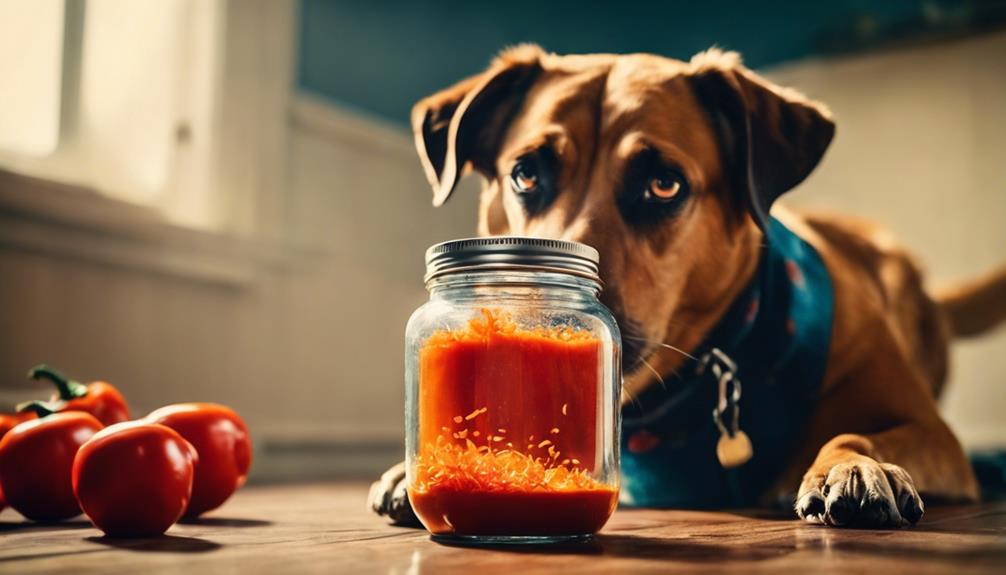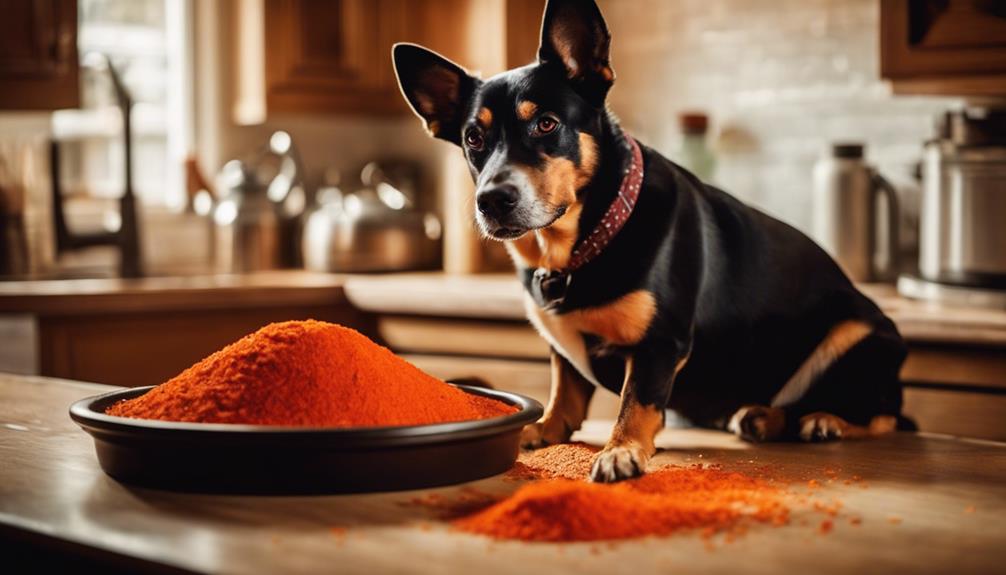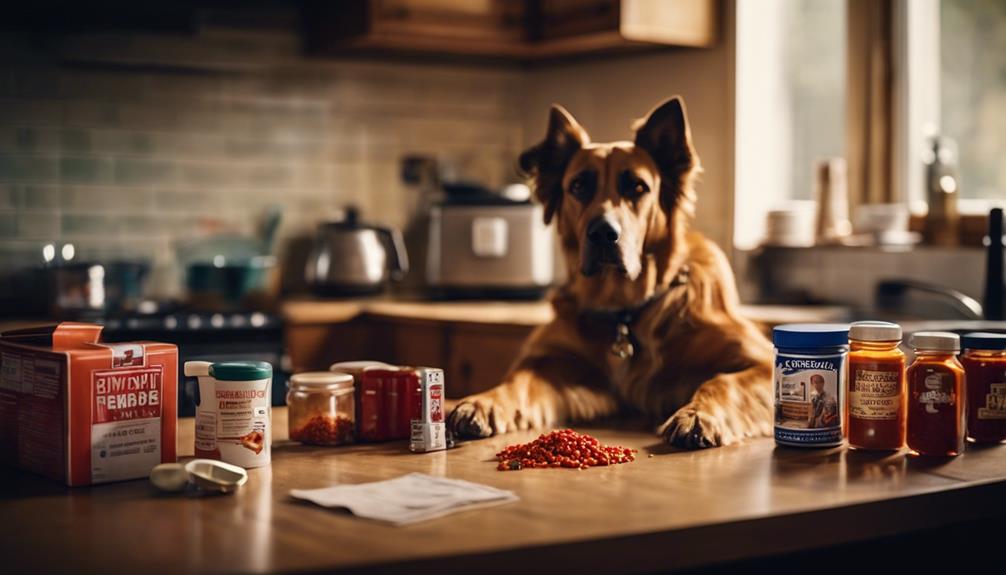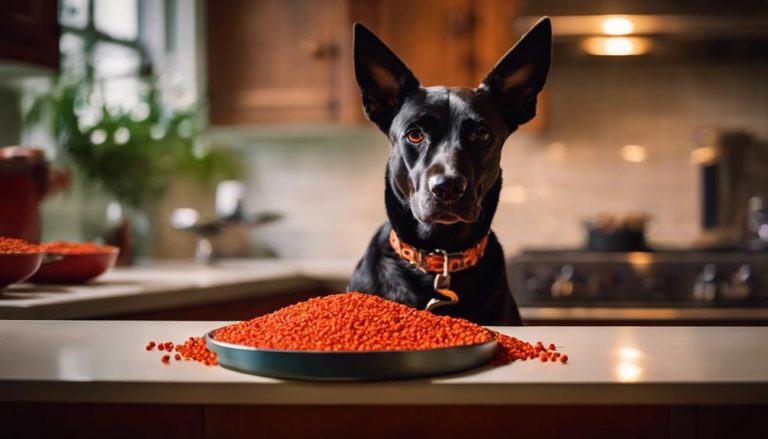Paprika: Safe for Dogs?
Paprika comes from sweet pepper pods and appears in hues from bright orange-red to deep red. It’s a staple in human dishes, offering sweet and hot flavors. However, sharing this spice with your dogs is not a good idea. Eating paprika might upset your dog’s stomach, leading to discomfort, vomiting, diarrhea, or even an allergic reaction such as skin rashes. Instead of paprika, bell peppers are a much safer choice for your pet.
If your dog accidentally eats paprika, watch for signs like restlessness or excessive drooling. Watching them and understanding how different seasonings can affect their health is vital. This knowledge helps in avoiding potential health issues in dogs.
Key Takeaways
- Paprika may upset your dog’s stomach.
- Look for vomiting or diarrhea if they eat it.
- Opt for bell peppers, a safer dog treat.
Paprikas Composition
Paprika comes from grinding sweet pepper pods, and its color can range from a bright orange-red to a deep, rich red. This depends on the type of pepper used. Sweet paprika is made mainly from red bell peppers and has a gentle, sweet flavor that works well in many recipes. On the other hand, hot paprika, often found in Spanish cuisine, might include chili peppers or a mix of chili and bell peppers for a spicier kick.
The different tastes of paprika, from sweet and gentle to sharp and spicy, make it a flexible ingredient in the kitchen. However, regarding dogs, spicy foods and the risk of upsetting their stomach, especially with hot paprika, suggest it’s best to be cautious.
Paprika Safety for Dogs

Paprika might not directly poison dogs, but it can make them uncomfortable. This spice, often derived from chili peppers, can upset a dog’s stomach, leading to digestive discomfort. Pet owners should find safer food additives that won’t cause their dogs any trouble.
| Aspect | Consideration |
|---|---|
| Toxicity | While paprika isn’t poisonous, it can lead to stomach upset and digestive problems. |
| Alternatives | Consider using bell peppers instead, as they offer similar nutrients without causing spiciness-induced discomfort. |
| Symptoms | Preventing paprika from your dog’s diet is wise to avoid issues like vomiting and diarrhea. |
Feeding dogs something that doesn’t align with their digestive system is a quick way to alleviate discomfort. Even though paprika itself isn’t deadly, its spice level and ingredients can make your dog feel ill. For your dog’s health and happiness, opt for alternatives like bell peppers that can provide the same nutritional benefits without the risk. This way, you can ensure your dog stays healthy without discomfort.
Symptoms of Paprika Ingestion

When dogs eat paprika, they might start to feel sick. This can include upset stomach, throwing up, and having diarrhea. These symptoms show that paprika doesn’t sit well with their digestive system. If things worsen, dogs might drink more water or drool a lot, trying to eliminate the irritant. Some dogs could seem uncomfortable or restless, which means they’re not feeling well.
In more severe cases, dogs could have an allergic reaction to paprika. This might look like skin rashes, scratching, or even trouble breathing. It’s crucial to keep an eye on your dog after they’ve eaten paprika. Look for minor signs like licking their lips or acting differently, as these can be hints that they’re feeling nauseous or having a bad reaction.
Safe Seasonings for Dogs

Understanding which seasonings are safe for dogs is critical to ensuring their meals are enjoyable and non-harmful. While a sprinkle of certain herbs can make a dog’s food more appealing, it’s crucial to steer clear of paprika due to its potential to upset their stomach. Spicy ingredients, in particular, are known to cause discomfort.
To avoid breathing problems, ensure your dog doesn’t sniff powdered seasonings. Always talk to your vet before adding new things to your dog’s diet to ensure they’re okay. Paying close attention to how your dog reacts to new seasonings is vital for catching any adverse reactions early and keeping them healthy.
Emergency Responses

If your dog eats paprika, you must watch them for any stomach troubles, but you usually don’t have to rush to the vet. Paprika isn’t poisonous for dogs, but it could upset their stomachs. Watch out for signs like nausea, vomiting, and diarrhea because these could mean your dog’s not handling the paprika well. If your dog seems nauseous, a simple antacid approved by your vet might ease their discomfort.
Should your dog rub against a lot of paprika, they might get a skin rash. It’s crucial to watch for any unusual behaviors or signs of health issues, such as drinking more water than usual, which could suggest a reaction to the paprika.
Frequently Asked Questions
What Spices Are Safe for Dogs?
- Turmeric benefits dogs without harm.
- Ginger offers safety for canine consumption.
- Basil is helpful, but watch for nutmeg and saffron doses.
What Happens if a Dog Sniffs Paprika?
- Dogs may sneeze a lot after sniffing paprika.
- Paprika might inflame their nasal passages.
- Respiratory issues could arise from paprika exposure.
Can Dogs Eat Potatoes With Paprika?
- Avoid paprika in dog’s potatoes for health.
- Cook potatoes safely, ensuring no toxic ingredients.
- Serve in small portions suitable for your dog.
Can Dogs Have Cinnamon?
- Dogs can eat cinnamon, but watch the amount.
- Look for allergies when giving cinnamon to your dog.
- Balance cinnamon’s benefits with its potential risks for dogs.

